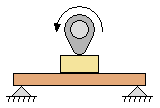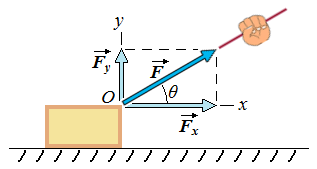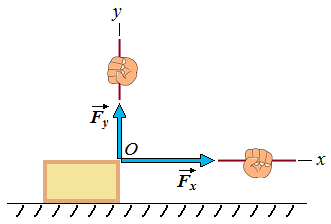
Fig3. Static load.

Fig4. Impact load.

Fig5. Variable load.
| Force |
 1 and
1 and  2 act at the same time at point A of the body shown, the effect on the body's motion is the same as the effect of a single force
2 act at the same time at point A of the body shown, the effect on the body's motion is the same as the effect of a single force  equal to the vector sum of the original forces:
equal to the vector sum of the original forces:  =
=  1 +
1 +  2. More generally, the effect of any number of forces applied at a point on a body is the same as the effect of a single force equal to the vector sum of the forces. This important principle goes by the name superposition of forces.
2. More generally, the effect of any number of forces applied at a point on a body is the same as the effect of a single force equal to the vector sum of the forces. This important principle goes by the name superposition of forces.
 acts on a body at point O.
acts on a body at point O.

 in the directions Ox and Oy are
in the directions Ox and Oy are  x and
x and  y. When
y. When  x and
x and  y are applied simultaneously, as in the next figure, the effect is exactly the same as the effect of the original force
y are applied simultaneously, as in the next figure, the effect is exactly the same as the effect of the original force  .
.

 in terms of its x- and y-components Fx and Fy rather than by its component vectors. For the case of the above two pictures, both Fx and Fy are positive; for other orientations of the force
in terms of its x- and y-components Fx and Fy rather than by its component vectors. For the case of the above two pictures, both Fx and Fy are positive; for other orientations of the force  , either Fx or Fy can be negative or zero.
, either Fx or Fy can be negative or zero.
 Fig3. Static load. |  Fig4. Impact load. |  Fig5. Variable load. |
| Static loads are steady, constant or are applied slowly. The load does not change very much in value. Examples include the weight of a fluid in a storage tank and the dead weight of a structure upon it supports. | Impact loads are applied suddenly, usually at high velocity. There is, frequently, actual impact (a blow) on the machine member by another machine member or some external body. Impact loads are common to such machines as pile drivers and punch presses, to name a few. | Variable loads are applied in various ways, but in each case the value of force is variable. In some cases the load is constantly varying, as in the connecting rods in an engine. An extreve condition is typified by a rotating shaft which experiences a complete reversal of load on each cycle. If fibers along the top of a shaft are stressed in compression, those along the bottom are stressed in tension. At any point on the shaft, each revolution produces a change from tension to compression. |